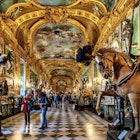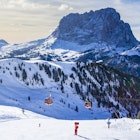
Outdoor adventures in Tyrol: where Italy meets Austria
Jul 19, 2019 • 5 min read

The dramatic Dolomite peaks, rising behind verdant Alpine pastureland. Creativaimage / Getty Images
Characterised by towering peaks, gushing mountain streams and verdant Alpine meadows, the historic region of Tyrol spans the borderland between northern Italy and western Austria. It’s the perfect destination for outdoor enthusiasts, as there are a huge range of activities on offer, from hiking and biking, to rafting, horse riding and climbing.
Historically part of the Holy Roman Empire and Austrian Empire, nowadays the Tyrol is split between two countries and three regions. The northernmost portion is Austria’s Tyrol region, the central part is Italy’s South Tyrol (where the majority of people speak a German dialect) and the southernmost part is the majority-Italian-speaking Trentino region. In 1998 the whole area was declared a Euroregion, to help encourage cross-border cooperation. Once made up of poor and isolated mountain communities, the region has now made its fortune as an outdoor destination, particularly in winter, when skiers flock to its upmarket resorts.

Innsbruck
Innsbruck is the capital of Austria’s Tyrol region, and its international airport is an important entry point for the area. The city has lots to offer for visitors, with attractive architecture in its old town and lively nightlife thanks to its large student population; however the real standout feature is its setting in the Inn river valley, with lofty mountain ranges framing the skyline from north to south.
North of the city, the jagged peaks of the Nordkette rise to over 2000m and are easily accessible by cable car within half an hour from the centre. A funicular runs from the Congress Centre to Hungerburg, then the first cable car runs up to Seegrube (1,905m), where you can catch the second right to the top of the ridge at Hafelekar (2,300m). There are numerous hiking trails from both upper stations, and in winter there’s a ski area here, including the famously steep black run down from Hafelekar. From Hafelekar a dramatic via ferrata (protected climbing route) runs along the top of the ridge, and from Seegrube the extremely challenging Nordkette Singletrail mountain bike trail runs 3.2km down to Hungerburg.
The Ötztal valley and Area 47
West of Innsbruck, the Ötztal valley is the longest side-valley, running right up to the border with Italy at the Timmelsjoch pass. It's a fantastic destination for outdoor activities, with hundreds of peaks to hike up, loads of scenic routes for mountain biking and e-biking, and excellent glacier skiing at ³§Ã¶±ô»å±ð²Ô and off-piste skiing at Obergurgl. It’s also a great destination for climbers, with dozens of crags and hundreds of climbing routes, some multipitch. The area also has some spectacular via ferrata routes, including a rather terrifying one that involves shimmying across a single wire that spans the top of the 159-metre Stuibenfall, Tyrol’s highest waterfall.
The perfect place for watersports fans is Area 47, located at the bottom of the valley, where the Ötztaler Ache river joins the river Inn. Whitewater rafting is the highlight here, with two options available: the more demanding and technically difficult route goes from Oetz on the Ötztaler Ache river, whereas the ride along the Inn river from Imst is suitable for families, but still very exciting. Area 47 also offers canyoning tours, sliding and abseiling through nearby gorges, and a fascinating caving tour through tunnels dug by the Nazis during WWII. Area 47 is also a huge adventure park with water slides, wakeboarding, climbing walls and high-ropes courses.
The Dolomites
Over the border in Italy’s South Tyrol region the main attraction for outdoor adventurers is the Unesco-listed Dolomites mountain range. The landscape here is strikingly beautiful, characterised by pale, vertical rocky pinnacles and outcrops that glow red in the morning and evening light. In the isolated valleys, such as the Val Gardena and Val Badia, locals live in pretty mountain villages and still speak Ladin, an ancient language related to Latin.
The area is famed for its excellent hiking, biking and climbing, plus some of the world’s best via ferrata routes, such as the breathtakingly exposed but technically relatively straightforward Via Ferrata Tridentina. For a change of pace and scenery, head for the Alpe di Siusi, Europe’s largest high-altitude Alpine meadow, where dozens of family friendly hiking routes and bike paths crisscross the gently undulating grassy plateau. In winter the whole area becomes a huge playground for skiers and snowboarders, connected up by the extensive Dolomiti Superski pass that gives access to 450 lifts and 1200km of ski runs. The quintessential experience is to ski the Sella Ronda, a series of interlinked lifts and runs that allow you to circumnavigate the Sella massif in a day, either clockwise or anticlockwise.
Reinhold Messner, one of the greatest living mountaineers, hails from this region, and in recent years has dedicated himself to creating the , a series of six museums that explore humankind’s relationship with mountains. Each museum focuses on a different aspect of the mountain experience, and all occupy scenic locations, from hilltop castles to a Zaha Hadid-designed structure thrust through the top of a mountain.

Lake Garda and the Brenta Dolomites
The Italian region of Trentino also claims part of the main Dolomites range, in addition to its own exclusive range, the Brenta Dolomites, situated west of the Adige river. It too is a fantastic destination for skiing, hiking, mountain biking, climbing and via ferrata. The area is particularly blessed with mountain lakes, perfect for cooling off in the heat of summer. One of the most beautiful is Lake Molveno, which is bordered by an auditorium of Brenta Dolomite peaks. A great way to experience the lake and its towering surroundings is a tandem paragliding flight, where you can soar like a bird past the craggy rock faces and over the gem-bright turquoise waters of the lake.
But the real jewel in Trentino’s crown is Lake Garda, Italy’s largest lake. With powerful and consistent winds driven by its location at the base of a deep valley, the lake is a magnet for sailing and windsurfing enthusiasts. Just a few kilometres north of the lake, the town of Arco is a world-class sport climbing destination. A dozen excellent limestone crags sit within easy reach of the town, some with impressive views down over Lake Garda. The town, which hosts the Rockmaster climbing festival each year, is exceedingly welcoming to climbers, and the local authorities ensure that safety standards on the crags are exceptional, with protection regularly upgraded.
Anna Tyler travelled to Italy and Austria with support from the Trentino, South Tyrol and Tirol tourism boards, and the Adventure Travel Trade Association. Ïã¸ÛÁùºÏ²Ê¼´Ê±¿ª½± contributors do not accept freebies in exchange for positive coverage.
Explore related stories



 SkiingWhere to ski in Switzerland from popular resorts to off-piste slopes
SkiingWhere to ski in Switzerland from popular resorts to off-piste slopesNov 5, 2024 • 6 min read






